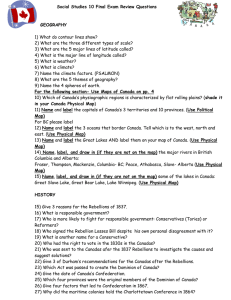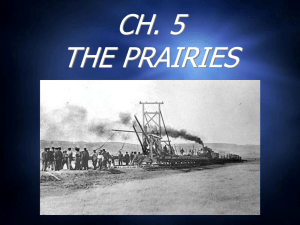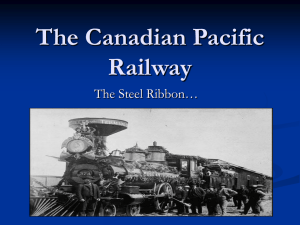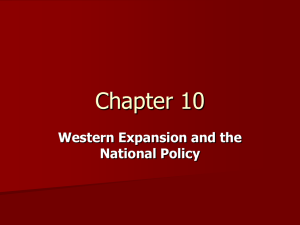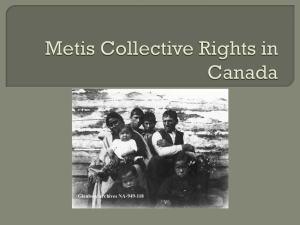File
advertisement
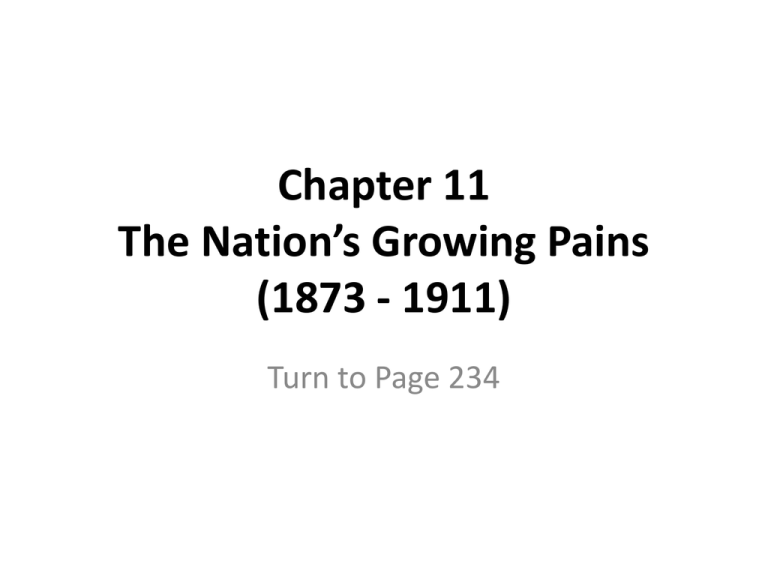
Chapter 11 The Nation’s Growing Pains (1873 - 1911) Turn to Page 234 Liberal Administration 1873 – 1878 Pg. 237 • Macdonald promised a railway “From Sea to Sea” • Awarded the CPR contract to Sir Hugh Allan • It became public knowledge that Allan had donated $325 000 to the Conservative Party during the 1872 election • Macdonald’s Conservative gov’t accused of accepting a bribe in exchange for the railway contract • This was called the Pacific Scandal • Macdonald resigns and the Mackenzie’s Liberal gov’t takes over Northwest Territories Act, 1875 See Map Pg. 238 • Initially, NWT governed from Ottawa with no gov’t of its own • Then, placed under control of the lieutenant governor of Manitoba • Long delays before decisions made because needed federal gov’t approval on everything • This Act – gradual implementation of representative government as more people immigrated here • Given their own lieutenant governor + appointed council of 5 members • When the population increased, it would receive more of a political voice Indian Act, 1867 Pg. 238 • Governs the First People and their lands • Aim: Move the First People onto reserves and use the remaining lands for settlement • Assumed the First Nations would assimilate • Isolation policy of reserves – Educated, Christianized, and protected until they were fully assimilated into the dominant Canadian culture and society Conservative Administration 1878- 1896 Pg. 239 • Macdonald’s Conservative Party introduced a new policy called the National Policy – Protective Tariffs – National Railway – Settlement of the West • Canadians responded well and re-elected J.A.M. and his party in 1878 Macdonald’s National Policy Pg. 240 1. Protective Tariffs – To encourage development of Canadian industries and raw materials – High tariffs (import taxes) were to be put on goods that Canadian industries could make – Tariffs would make goods from other countries more expensive than Canadian goods, so Canadian industries would sell more – Would generate money for the railway Macdonald’s National Policy Pg. 240 1. Protective Tariffs – Fortunately, a world-wide period of prosperity began soon after the Conservatives returned to power – It appeared that J.A.M.’s National Policy worked a miracle because business increased – However, actually was due to the world-wide business boom and renewal of timber trade with U.S. Macdonald’s National Policy Pg. 240 2. National Railway – In 1880, the CPR was formed – Take settlers to the West; bring crops to the East – Task of building a transcontinental railway that would go from Montreal to the west coast of B.C. – A tremendous accomplishment – Canada population with only 4 000 000 completed its railway only a few years after the U.S. did (a nation with 10 X the population) Macdonald’s National Policy Pg. 240 3. Settlement of the West – Population growth not good – 1890s, more people leaving Canada than coming in from other countries – Dominion Lands Act 1872, gave settlers 64 hectares of land in return for a $10 registration fee with the condition that one must live on the land and work for 3 years – Prairie farmlands were surveyed into townships (divided squares of land) – U.S. West more attractive because of free land and railway The Canadian Pacific Railway (CPR) Pg. 241 • CPR completed in 1885 under the leadership of William Cornelius Van Horne • Very expensive; gov’t promised money, land, railway lines, and no taxes to the private company • Northwest Rebellion (Native resistance) – Van Horne transported soldiers to the West although some places unfinished – People very impressed by the speed of the railway and protection – Gov’t loans more money to the CPR The Canadian Pacific Railway (CPR) Pg. 241 • William Cornelius Van Horne – In 1882, hired as General Manager of CPR – Very ambitious – In 10 years, only 480 km completed; Van Horne built 830 km in one year – CPR completed 6 years before the estimated date – The West now ready for settlers • Donald Smith and the Last Spike (See Pg. 242) – Nov 7, 1885 – Craigellachie, B.C. Northwest Mounted Police Pg. 244 • Created Aug 1873 • Since Canada purchased Rupert’s Land in 1869, not easy to enforce the laws of the western lands • No one to stop the American traders selling whiskey to the Native peoples • Cypress Hills (Massacre), which are in Alberta and Saskatchewan, demonstrated the need for police – American traders killed 30 Assiniboine people • Stopped whisky trade, advice to settlers, carried mail, fought fires, helped with Native conflict Seven Treaties Pg. 246 • The Caucasian thinking was to move the First People out of the way for European settlement • Many people moved into areas set aside for the First People • J.A.M. believed the First Nations should be assimilated • Needed to resolve all land claims before settlers could move in Seven Treaties Pg. 246 • From 1871 – 1877, seven treaties signed between the Canadian gov’t and the First People living between Lake Superior and the Rockies • In return for their lands, First People received reserve lands, a lump-sum payment, yearly payments, and a school on each reserve • Empty promises; disease and whisky traders weakened the First People; forced to accept the terms • Those who signed treaties and their descendant called “status Indians” • Those who did not sign and their descendants known as “non-status Indians” • Read Page. 247 Causes of NW Rebellion Pg. 249 • Read Page. 248 • The Manitoba Act of 1870 set aside 500 000 hectares for the Métis • Gov’t surveyors came in 1878 • Métis could not understand why some land lots were recognized while others not • Without proper gov’t survey, could not get official title to the land • Slow distribution of promised lands • More and more settlers coming into Manitoba and soon outnumbered the Métis Causes of NW Resistance Pg. 249 • By 1885, community of Metis on the North Saskatchewan River (about 500 people) • National Policy – settle the West; 25 000 new settlers arrived between 1871 – 1881 • West was changing - buffalo and Native lifestyle disappearing; Metis farmers threatened by new settlers • Metis frustrated with the lack of response from J.A.M. Causes of NW Resistance Pg. 249 • Louis Riel suffered an emotional breakdown and spent two years in a Quebec asylum after the Red River Rebellion 1869/70 • 1875, granted amnesty (pardon for past offences) if he stayed in Canada for 5 years • Marries in Montana • June 4, 1884, four man delegation, including Gabriel Dumont arrived in Montana to get Riel to Saskatchewan Events Leading to Resistance Pg. 249/50 • 1884 Summer, Riel returns to the Saskatchewan River • Decided to petition to Ottawa • Concerns of the Metis, the First People, and the settlers • Asked for responsible gov’t for the NorthWest, with control over resources and representation in the federal Cabinet + Parliament • Wanted provincial status for the District of Saskatchewan Events Leading to Resistance Pg. 249/50 • Letters sent to Ottawa to warn them of trouble if they did not respond to the complaints • PM J.A.M. drew up a list of all the Metis who were eligible for scrip and land grants • Scrip: certificate or coupon that was given as compensation for land, entitling to a choice between land or cash Events Leading to Resistance Pg. 249/50 • March 19, 1885, Riel sets up a provisional or temporary gov’t (similar to the one in Manitoba) • Gabriel Dumont appointed the military leader • Most First People decided to not take up arms against the federal gov’t except for the bands of Poundmaker and Big Bear An Armed Uprising Pg. 250/1 • North-West Resistance began March 26, 1885 Battle at Duck Lake • Gabriel Dumont and Metis attacked Superintendent Crozier of the NWMP • 12 of C’s men killed, 11 wounded; 5 Metis killed • Poundmaker to Battleford for food • April 2 Frog Lake Battle – Big Bear’s men killed 9 people including Thomas Quinn, gov’t agent An Armed Uprising Pg. 250/1 • J.A.M. “The North-West Rebellion saves the CPR” – sends 8000 soldiers on the unfinished track • Major-General Middleton of Canada divided into 3 groups: Metis at Batoche, Poundmaker at Battleford, and Big Bear • Riel believed God told him to stay in Batoche and defend; Dumont wanted to hit-and-run • May 9 -12 Battle at Batoche (Pg. 250/1) • Riel and company surrender Louis Riel Trial Pg. 252 • Watch Heritage Minute • Riel on trial for treason • Found guilty by a jury of six English-speaking Canadian men • Jury asked for mercy, but the judge had no power to stop the execution • Petitions and debates of not hanging him • 2 months for J.A.M. to make a decision • Would lose many votes in Quebec • Riel hung Nov 16, 1885 Effects of the NW Resistance Pg. 252 • Completion of the CPR • Riel’s hanging caused a rift between English and French Canada • Direct insult to French-Canadians • English Canadians felt that French-Canadians had no right to demand special treatment • Many blames J.A.M. for the problems in the NW • Riel: A rebel, a hero, or insane? • 1992, 100 years after the NW Resistance, the Canadian Parliament recognizes Riel’s contributions Military Leaders Pg. 253 • Dumont: Great rider, marksman, spoke French and six Native languages, hit-and-run guerrilla strategy, joined “Buffalo Bill” Cody’s travelling Wild West Show • Major-General Frederick Middleton: led the Canadian Militia, Battle of Fish Creek and Batoche • Poundmaker: Cree chief, his people had a hard time adjusting as farmers, frustrated and went to Battleford, Colonel Otter defeated, jailed after • Big Bear: unhappy with gov’t treatment of First Nations, he wanted a peaceful resistance, but his followers took up arms French Canadian Nationalism Pg. 255 • Becomes a challenge to Confederation • French-Canadians viewed it as an agreement to guarantee French and English equality • Seemed that biculturalism rejected in English Canada • Eg. 1871 New Brunswick gets rid of Roman Catholic schools; 1890 Manitoba replaces dual system with only English • Fear of English Canadian culture assimilation Henri Bourassa Pg. 255 • Journalist, Liberal, and Member of Parliament • Championed the rights of Canada’s French-speaking minority • Wanted equality between French and English • Argued that French language and Roman Catholicism should be protected • “Selective immigration…no railway…too many English settlers coming” • Break ties with Britain Manitoba Schools Question Pg. 255 • 1870, Confederation, half the population French-speaking • Schools were Roman Catholic supported with a subsidy from the HBC • Over the next 20 years, English immigration outnumbered French-speakers • 1890, Manitoba voted to set up a single English public school system (no duality) • Read Pg. 255 Manitoba Schools Question Pg. 255 • French Catholics appealed to J.A.M. • No-win situation – If it supported the French Catholics would be seen as interfering in provincial affairs – If it did not support the Catholics, it would lose votes in Quebec • More problems – five P.M.’s in four years • 1895 – Conservative gov’t prepared a bill to give back the rights to the French-speaking Catholics, but an election called before it became a law Manitoba Schools Question Pg. 255 • Wilfrid Laurier and his Liberal party won in 1896 • Compromise with provincial leaders – The provincially funded, nondenominational public school system remained in effect – If enough students, religious teaching in the last half-hour of the school day – If 10 or more students spoke one language, taught in that language The Last Best West Pg. 257 • From 1900 to 1914 • A flood of immigrants into western Canada from Ontario, Britain, and the U.S. • Six Reasons Pg. 257 • Slow to encourage western settlement; not until good land in the U.S. filled up Clifford Sifton Pg. 257 • Enthusiastically promoted immigrant settlement in the West • Wilfrid Laurier (Liberal PM) appointed him to be Minister in charge of immigration • Placed ads in 6000 newspapers in the U.S. • Gave American newspaper editors free trips to the Canadian Prairies, so they could see the inexpensive, fertile land • Sent advertising agents to the British Isles, Central and Eastern Europe • Many in Europe would not get the chance to own a large farm; owned small ones with high taxes or were tenant farmers Alberta + Saskatchewan Pg. 267 • NWT concerned whether the territories should be granted provincial status • Canadian gov’t argued that there were too few people • Sept 1, 1905 – Alberta and Saskatchewan created • They were promised: cash, yearly cash, taxes used to support separate Protestant and Roman Catholic schools • French language + denominational schools (run by religious group) Alberta Pg. 268 • Edmonton or Calgary as the capital city? • Edmonton: – Geographic center of the province – Early trading post; center of activities for many years • Calgary: – Located on the main line of the CPR – Center for the cattle industry • Frank Oliver, MP, made Edmonton the capital Saskatchewan Pg. 269 • Sept 4, 1905 Inaugural day • Crowds, bands, bunting (strips of cloth used as holiday decorations), parades, speeches, new lieutenant-governor, musical rides, ball • Six cities wanted to be capital city • Regina already had the distinction of being appointed capital of the NWMP and part of the CPR line • Saskatoon invited important people to a lavish banquet • Regina voted 21 to 2 as the capital city
